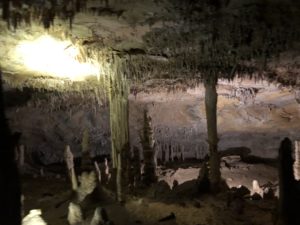Located in the northwestern portion of Idlewild Park, the California Building is the only remaining architectural remnant of the Transcontinental Highway Exposition of 1927.
Idlewild Park was created for this exposition which celebrated the completion of the Lincoln and Victory highways (present day U.S. 50 and U.S. 40). In 1913, members of the automobile industry began raising money to create a hard-surfaced highway coast-to-coast, with accurate signs along its entire length. The Lincoln Highway Association was formed that same year to help complete this early transcontinental highway, and with assistance of the Federal Highway Aid Act of 1916 and 1921, their goal was soon reached. The completion of the highways opened Nevada up to the lucrative automobile tourism trade, and led to growth and development of communities along the highway routes. San Francisco landscape architect Donald McLaren designed the layout of the exposition grounds. McLaren, who designed the landscaping for the 1915 Pan-Pacific Exposition in San Francisco, also worked on the design of Reno’s Wingfield Park. Idlewild Park and the California Building were gifts from the neighboring state of California.
The California Building was constructed in the Mission Revival architectural style, appropriate as a representation of that state’s Spanish and Mexican heritage, and features stuccoed walls, clay tile roof, a bell tower and arched openings. It was the grandest exhibit at the exposition. In honor of those who fell in combat in World War I, the California legislature dedicated the building, “To the memory of those who gave the last full measure of devotion to this nation.” At one time, Idlewild Park included a zoo, a fish hatchery and a Civilian Conservation Corps (CCC) camp. Today, the California Building is the only remaining building constructed for the Exposition, reminding Nevadans of their role in early transcontinental highway development. It is currently owned by the City of Reno as a recreational facility and has undergone exterior refurbishment partially funded through the Nevada State Historic Preservation Office.
Pictures below are provided by contributors or supporters of this website. If you are interested in sharing your pictures of Nevada, please drop us a note.

Courtesy S. Ward – Inside Lehman Caves